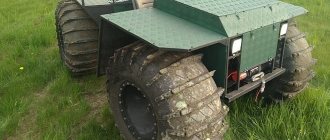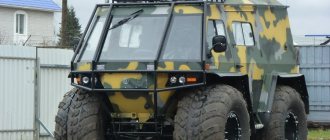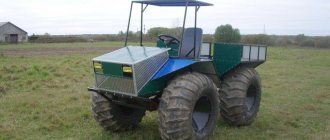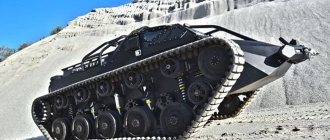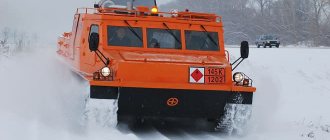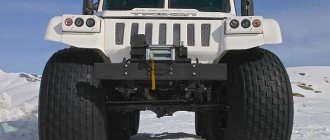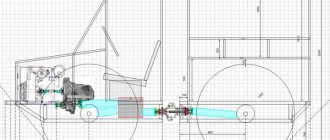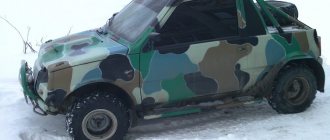The article is compiled based on forum materials, link to source
Some information on the caracat, although everything is clear from the photographs, but it may still be interesting. The engine is from an IZH Planet motorcycle, the left cover with a fan is from an SZD disabled person. The standard electrical equipment was replaced with Voskhodovskoe, which does not require a battery and is much more reliable since it has a chroll sensor instead of cams.
UAZ differential and two long UAZ axle shafts. The axle shafts are shortened since the karakat karakat would turn out to be very wide. The original hubs are cut and pressed from Moskvich ones, since the wheels are made on the basis of lighter Moskvich wheels.
The motorcycle wheel disk is halved and a disk for the Bel-79 is made on its basis. In general, two sets of wheels were made, one based on Bel - 79 for mud, one based on tubes for swamps. Upon completion, an unexpected thing emerged: the tube wheels turned out to be somewhat heavier. This year the summer was dry and on the factory wheels we drove through the swamp without any problems; I haven’t “put on” the tube ones yet.
The frame is reinforced with gussets, at the bottom at the engine mount and in the fork mount area. A bronze bushing is inserted into the fork mount for strength, since even without such loads as in the swamp near IZH, the bearings break in this place. The body is made of sheet aluminum and aluminum corner with rivets:
The price of the karakat turned out to be very decent, but this is because a lot had to be redone during the work, since there was no experience in manufacturing just such devices. Various technical problems were also solved along the way. The design mainly used only new parts and materials, which is why the price was high. The device is being modified as it goes into use; it has been out through the summer and half of the fall through mud swamps, etc. no problems so far. Below are photographs of the making of this all-terrain vehicle.
The caracat's cross-country ability is excellent, it rushes through the swamp as it should, the engine is high-torque and even with a load it moves confidently through a completely off-road swamp. Very maneuverable and well controlled, of course not like a regular motorcycle, but quite normal and not heavy. In the north of the Omsk region and in Tyumen it is very rare to see a four-wheeled carakat; three-wheeled ones have been tested by time, and they are simpler in design than four-wheeled ones, less iron and components, which means more reliable.
And this caracat is, so to speak, the prototype and predecessor of this caracat.
Checking the caracat's buoyancy, as you can see, it floats on the water and not badly. There is a current on the river, so I tied it with a rope; when crossing a river, we usually tie such devices to a motor boat and then cross it that way.
Read also: Contract for the purchase and sale of a vehicle with a license plate
Photo of the rear drive from below
It took 63,000 rubles to build and finalize this karakat, this price was due to the fact that everything we needed for its construction was purchased new, even the smallest thing, the work of a turner and so on. The engine was overhauled, replacing the piston, we bought a left cover with cooling from a disabled person and more.
CyberPower UPS Inverters
uninterruptible and autonomous power supply systems (boilers, alarms, video surveillance, etc.)
The use of standard vehicles in off-road conditions, typical of rural areas and remote areas of the country, seems impossible due to their insufficient cross-country ability. Having figured out how to make a karakat with your own hands, the user will be able to cover long distances without any problems, being far from the roads.
What types of caracats are there?
Before figuring out how to independently make a karakat swamp rover from improvised mechanisms, it is necessary to take a closer look at the existing varieties of this kind of product. The Karakat swamp all-terrain vehicle is nothing more than a non-standard vehicle that moves with the help of wheels on which low-pressure tires are installed.
Among its main advantages:
- excellent maneuverability;
- low cost;
- maintainability;
- high power (depending on the spare parts used).
Such mechanisms are most often constructed independently on the basis of some equipment, for example, a tractor or walk-behind tractor. Existing models differ from each other not only in characteristics, but also in design. The most widespread are all-wheel drive and three-wheel drive devices.
All-wheel drive
All-wheel drive models seem to be the most popular transport option among consumers. They are equipped with 4 wheels, thanks to which the design is stable and has high maneuverability. Such a caracat can overcome even impressive obstacles without any problems, but its assembly will require two wheels of the same diameter.
To make such a swamp vehicle, the breaking with your own hands must be done correctly, otherwise there is a high probability of assembling an inoperable structure.
Three-wheeled
An equally popular modification can be considered models of swamp vehicles with three wheels. Such vehicles are lightweight and have the same cross-country ability as their all-wheel drive counterparts. Such an option will be optimal if you need to quickly make high-quality karakat. Do-it-yourself fracture can be done if you have the necessary equipment.
Maintenance and repair
The ZIS-5 snow and swamp-going vehicle does not require special maintenance, because For its production, time-tested spare parts from domestically produced trucks are used, incl. and UAZ. These include axles, gearboxes, wheels, driveshafts and other factory-reconditioned parts.
Because in Vologda there are a large number of companies that produce similar all-terrain vehicles such as Vepr, Okhotnik and Taiga; to repair the ZIS-5 you can purchase the necessary parts and various units from them. In addition, at car markets and car dismantling yards you can find a variety of used spare parts for repairing this car.
How to adjust valves
If necessary, the driver can independently adjust the valves of a four-stroke engine without resorting to the services of specialists. To do this, you need to perform a number of actions:
- Remove the cap from the cylinder (with an 8 mm wrench) and unscrew the spark plug.
- Using a 13 mm wrench, turn the crankshaft clockwise until the camshaft gear with holes is at top dead center (both valves are closed).
- Use a feeler gauge to measure the gap between the pusher and the rod and set the required gaps on the intake and exhaust valves (they should be 0.05 and 0.1 mm, respectively).
- If they do not match the required dimensions, you need to loosen the lock nut using a 9 mm wrench while simultaneously checking the gaps with a feeler gauge. To decrease the gap, turn the adjusting screw clockwise, and to increase it, turn it counterclockwise.
- If the feeler gauge moves tightly and is not pinched between the valve and the pusher, the gap is set correctly.
After setting the gaps on the intake and exhaust valves, it is necessary to assemble all the cylinder parts in the reverse order.
Stages of creating a homemade karakat
If you want to construct a Vologda swamp vehicle, the Karakat, or its other models at home, you should first of all purchase the necessary tools in advance, as well as acquire suitable components.
Read also: Set pid for torque
The complete list of necessary components and tools may vary and directly depends on the selected vehicle model that is planned to be manufactured. When analyzing the assembly process of such a product, it is necessary to highlight several important stages:
- Selection of the frame of homemade tractors or motor vehicles, which will become the basis of the future device.
- Planning and assembly of the rear axle and vehicle suspension.
- Selection and installation of suitable wheels.
- Installation of the power unit.
Since these types of elements seem to be key in the design of a swamp vehicle, it is advisable to consider the features of their selection and installation in more detail.
The main structural element is the frame, on which other components and assemblies will be installed in the future. Its choice directly affects the appearance of the future caracat, as well as its performance characteristics. Experienced craftsmen recommend using the frames of old domestically produced motorcycles, for example, IZH or Ural, since it is much easier to make a karakat from a motorcycle than from a car.
Spare parts from them are characterized by low cost, high strength and optimal characteristics for use as the basis for a swamp vehicle. After all, such three-wheeled models boast high maneuverability and maneuverability, which makes them universal. During the manufacturing process, it is advisable to use a frame drawing due to the complexity of the assembly.
Suspension
When designing the chassis, it is strongly recommended to give preference to an independent type of suspension. This is due not only to the ease of its manufacture, but also to its excellent characteristics.
If the user does not have the ability to implement independent suspension, standard pneumatic wheels can be used.
Wheels
The choice of wheels for a future swamp vehicle must be given special attention, since its maneuverability, as well as ease of operation, depend on this. Large wheels from high-power trucks are perfect for this type of use.
Low-pressure chambers are used throughout, allowing the all-terrain vehicle to overcome even large obstacles. If desired, you can make karakat discs, which will significantly improve the appearance of the structure. It should be remembered that for pneumatic tires it is necessary to use only truck tire tubes, and not the wheels themselves.
Engine
After the installation of the wheels has been completely completed, you should begin installing the engine, as well as the accompanying mechanisms necessary for the correct movement of the vehicle. As mentioned earlier, it makes sense to give preference to powerful units equipped with liquid and air cooling. A good option could be a product with a Lifan engine.
In addition, a home-made design can use not only gasoline engines, but also diesel counterparts, which will significantly increase cross-country ability, as well as make the vehicle more economical. However, this motor option also has a number of disadvantages that should be remembered.
First of all, this is unstable operation and starting in conditions of low temperatures, which is especially important for caracats, since they are often used in winter. The speed performance of diesel units is significantly inferior to their gasoline counterparts.
Read also: Paint that changes color depending on temperature
Brakes
Since, subject to the correct selection of components and their installation, a karakat can develop impressive speeds on a more or less flat road, it is necessary to equip the design with brakes that can quickly stop the vehicle.
This is extremely important, since in off-road conditions it is often necessary to overcome large obstacles, the descent from which can significantly increase the speed of movement. For use in construction, in most cases it is recommended to choose drum-type brake mechanisms, due to their high efficiency.
How to make obodryshi
This is what homemade all-terrain tires are called. They are much cheaper than factory ones. As a basis, they take large-sized tires from a truck (GAZ-66, KrAZ-255, ZIL-131), tractor or airplane and cut off the excess material. The cross-country ability is explained by the low specific pressure on the ground, which in turn is due to the large area of the contact spot.
Before you make tires out of tires, you need to choose the type of tread.
It depends on what kind of surface you plan to move on.
- Dirt. Requires a self-cleaning protector.
- Wetland. A pattern with lowered grooves is used to provide improved traction.
- Snowdrifts, sand. A protector with closely spaced elements is used.
- awl;
- construction knife with a set of blades;
- grindstone;
- clamps for straightening automobile bodies or clamps;
- winch with cable;
- hammer;
- cardboard or tin tread template;
- chalk.
- The tire is cleaned of dirt. It should not be worn out inside, otherwise holes will appear in the rubber as a result of peeling.
- The pattern of the future tread is drawn using chalk according to the template.
- Using a construction knife, make a cut along the inner circumference.
- Near it, rectangles are drawn with chalk. They cut them out with a knife.
- The wire that appears in the “windows” is hooked with a winch hook and removed. The tire must first be nailed to the base.
- Cuts are made along the tread pattern drawn in chalk.
- Use pliers to pinch the edges of the hole and open it.
- The exfoliated material is torn off using a winch. During the process, the rubber is cut with a construction knife, periodically sharpening and changing the blades.
- Excess is removed from the side surface in the same way.
- Treat the tire with sandpaper and, if necessary, correct it with a hammer.
The camera is mounted on a homemade disk. The latter is made from an aluminum basin and carefully ground.
The tire is tied to it with a fire hose.
The area of the contact patch is regulated by internal pressure. Before driving onto hard ground, inflate the tire.
Reworking a walk-behind tractor
Walk-behind tractors are rightfully considered one of the most versatile types of agricultural machinery, which is why they are often used as the basis for various home-made units. Among them, home-made 4x4 mini tractors with a breakable frame are very popular, as well as caracats made from a walk-behind tractor, which in terms of technical indicators are in no way inferior to other types.
To successfully manufacture such a device from a walk-behind tractor, you will need to follow the following instructions:
- Weld the frame using a metal profile/pipe.
- Mount rear and front drives. To simplify the process, it is recommended to take the front axle, steering system, and other elements from the vehicle’s chassis.
- Install the motor, as well as the gearbox included in the design of the walk-behind tractor.
- Construct and secure the slopes, and then roll in the resulting structure.
It is important to note that for this type of swamp vehicle it is recommended to use a wheelbase with increased belt-type traction. Structures made from walk-behind tractors, as a rule, have impressive dimensions and can reach speeds of up to 70 km/h, which makes them universal and reliable off-road solutions.
In order for the karakat to have the necessary characteristics, it is necessary to use high-power walk-behind tractors, since the vehicle must not only move successfully, but also transport the driver, as well as various loads.
All-wheel drive Oka
To create this unique all-terrain vehicle, donors such as Oka, which habitually donated its body, UAZ, which donated strong axles to the SUV, and Niva with its durable transfer case, were used.
As for the features of the assembly, among them it is worth highlighting the wheels with tires from KrAZ, spaced from the body, mounted on discs with an offset, springs from the Volga cut into two leaves and its steering, which, although it did not give light turns, but cost zero, in contrast to the previously planned expensive hydraulic booster.
There were also weaknesses, which turned out to be CV joints that quickly fail, as a result of which the owner always has to carry a spare tire with him.
Snowmobile based on a walk-behind tractor, skis and bicycle parts
Agricultural work is carried out during the summer season. In winter, the engine of an idle walk-behind tractor is suitable as the power plant of an all-terrain vehicle for driving through snowdrifts, which you can assemble yourself. With the arrival of spring, he returns to his place.
Snowmobile diagram
A three-wheeled layout is offered. In front, instead of a skating rink, a double ski is installed. There is no cabin, the car is intended for short trips.
What you need
The following components are used:
- Bicycle frame.
- Cameras from a truck, for example KamAZ.
- Plastic skis (2 pcs.).
- Gearbox from an old Honda DIO scooter.
- Motoblock engine.
- Chains for transmitting torque.
- Sprockets (2 pcs.).
- Gas tank.
- A pair of wheels from a wheelchair.
- Metal barrel with a volume of 200 l.
- Steel shaft with bearings.
- Fire hose or strip of tarp.
A welding machine, grinder and plumbing tools are used. Bolts and nuts are used to secure some components.
Improvements
The Vologda Caracat ZIS 5 can be easily modified to suit your requirements. The most common types of alterations are:
- Installing a steering damper to make driving the all-terrain vehicle easier.
- Strengthening the frame so that the ZIS can be used in more extreme conditions.
- Installation of a windshield and awning if you need to use an all-terrain vehicle in winter.
- Equipped with a trailer hitch and towing eye to allow you to carry more cargo.
- Install halogen or LED headlights to use the ZIS 5 in the dark.
- Installing a softer seat with a shock absorber if you need to spend a lot of time on the all-terrain vehicle.
Assembly Features
The installation procedure for this vehicle is quite simple and similar to assembling a homemade all-terrain vehicle:
- At the first stage, a frame is assembled on which the engine will be mounted in the future.
- After the engine is secured, the frame is carefully painted to prevent metal corrosion.
- Steering will occur through the front chassis.
- The seats and fuel tank are taken from the same motorcycle.
- The installed gearbox has its own characteristics. Torsion in it occurs in the opposite direction, which does not prevent the unit from working normally, because the load on it will be minimal.
- Two coolers from the VAZ 2110 will be responsible for cooling.
- Wheels can be made from truck inner tubes.
- Disks can also be homemade.
- The lever is attached to the bridge, like spring-suspended clubs.
Ural motorcycle in winter through monstrous snowdrifts.
The result of the work should be a homemade all-terrain vehicle with low-pressure tires.
Its disadvantage can be the strong heating of the engine during prolonged operation, which is why cooling is required.
The appearance of a home-made all-terrain vehicle will depend on the capabilities of the person doing the assembly.
All-terrain vehicle from the Urals
In this case, the donor of the main components is the Ural motorcycle. For the needs of the carakat, a power of 32 hp is sufficient. It will be necessary to create air cooling. The rear axle in some versions of converted motorcycles can be taken from Niva.
Karakat from the Urals has a good load-carrying capacity. This design can comfortably accommodate four people. When overcoming water obstacles, some difficulties will arise, because... Water may enter the engine due to fan operation.
There are practically no problems when driving through mud. It’s a little more difficult when passing through deep snow, again the problem can be solved, the caracate’s speed just decreases slightly. Therefore, snowmobiles of this design can still be used when traveling on snowy off-road terrain.
Creating an all-terrain vehicle from a Ural motorcycle is quite simple; almost anyone with basic knowledge of auto mechanics can do it.
Karakat from Izh
Many craftsmen use their Izh motorcycle for modifications. The principle of choosing wheels remains the same as when equipping the converted Ural. The camera can be tied with straps. The width of such a strip is about 30 cm. The strips are fastened with bolts. If we take the frame from Izh as a basis, we will have to significantly lengthen it and further strengthen it. Discs can be taken from Niva.
Specifications
| Engine | Lifan 190FD |
| Power | 15 hp |
| Shaft location | Horizontal |
| Shaft diameter | 25 mm |
| Cylinder diameter | 90 mm |
| Piston stroke | 66 mm |
| Working volume | 420 cm³ |
| Compression ratio | 8.2:1 |
| Maximum output power | 10.5 kW at 3600 rpm per minute |
| Rated power | 8.5 kW at 3600 rpm per minute |
| Maximum torque | 25 N.m at 2500 rpm per minute |
| Ignition system | Contactless semiconductor |
| Launch | Electric starter and manual |
| Fuel tank capacity | 6.5 l |
| Fuel consumption | 374 g/kWh |
| Engine oil volume | 1.1 l |
| Dimensions (mm) | 403x449x525 mm |
| Package size (mm) | 525x455x525 mm |
| Lighting coil | 18 A |
| Weight | 36 kg |
| Brake system | Hydraulic |
| Transmission | VAZ |
| Bridges | VAZ |
| Length | 3200 mm |
| Width | 1870 mm |
| Height | 1450 mm |
| Ground clearance | not less than 450 mm |
| Wheel track | 1650 mm |
| Number of seats | 5 |
| Weight | 470 kg |
| Load capacity (including driver) | 300 kg |
| Maximum permissible speed | no more than 25 km/h |
| Maximum speed on water | 5 km/h |
| Price | 120 ... 150 thousand rubles. |
Now only mine bites!
I caught this pike using a bite activator.
I’ve never caught one of these before, but now every time I bring back trophy specimens from fishing! The time has come for you to guarantee your catch!!! Homemade swamp vehicles are not a new invention, but they are quite successful. The use of such machines is widespread among residents of remote parts of the country. People were forced to resort to their creation by the fact that there is a large amount of wetland around them, and they have to move through it. In addition, homemade swamp vehicles are much more profitable financially. Since buying a factory-made unit that is already assembled and ready for use is very, very expensive.
Do-it-yourself all-terrain vehicle fracture part 1 Design of a homemade all-terrain vehicle AOG-1 part 1
Why the simple Russian all-terrain vehicle “Sherpa” is loved all over the world
SWAMP TRAVEL WITH YOUR OWN HANDS? EASILY!!! TECHNICAL REVIEW.
What is important to consider?
Attention should be paid to work daily. If you are not sure that you can do this, then it is better not to start anything at all. Create a project for the future design in advance
If necessary, use the drawings of other inventors, fortunately there are a lot of them on the Internet. Plan your budget correctly. Yes, making it yourself will help you save a lot, but to do this you need to calculate the cost of consumables and purchase them in advance. You also need to set aside a little in case there isn’t enough.
As you can see, the described snow and swamp-going vehicles are very useful for difficult terrain. They are quite expensive, but if you have the skills and appropriate equipment, you can save a lot by building a vehicle with your own hands.
All-wheel drive lightweight swamp vehicle, frame "fracture". A very light and passable karakat with an economical engine. The photo after the overhaul with painting, so to speak, brought it into divine shape and corrected a few things.
>
>
This is before painting, so to speak, in the field
>
Sherpa all-terrain vehicles
>
Now a little about the design. The ZiD engine, single-cylinder, four-stroke, power, in my opinion, is only 3 l/s, seems to be intended for spinning an electric generator, I got a new one, so I started making it based on it. The Moskvichevskaya box, which I shortened. The engine is connected to the gearbox through a homemade clutch made from the flywheel of a “humpbacked” Cossack, its basket and clutch, and the release clutch guide is homemade. The Zaporizhia disk had to be riveted to fit the spline part onto the input shaft of the Moskvich gearbox. A reduction gearbox is installed on the engine.
Rear drive
>
>
>
>
>
About 600 km have already been covered on this caracate. Fuel consumption is about 1.5 liters per hour. If you noticed that the steering wheel is on the right, this was done because the cord used to start the engine came out from this side, and it’s more convenient to start it while standing on the frame with your right hand. Karkat is transported on a trailer, the trailer is from the Taiga farm. The wheels are removed before packing into the trailer and the caracat drives into the trailer under its own power on bare rims. It can be transported by any passenger car, it can be unloaded and assembled on site in about 20 minutes, there is a standard engine-driven compressor to inflate the wheels, the caracat is loaded with everything necessary and off-road.
Buy Sherpa all-terrain vehicle price in Russia
Despite the fact that the caracat does not have mudguards and does not splash with water, in the worst case, only the swamp boots suffer from the mud. And even then only along forest ruts. The speed of movement is low, so nothing is thrown from the wheels in all directions, and in the swamps there is nothing else except grass and water, there is no dirt.
The all-terrain vehicle is more designed for traction; it travels freely through the swamp with a load of 500 kg (fish, driver, passenger) at a speed of about 8-10 km/h according to GPS. Which is completely fine. When the car is not loaded, you can drive faster, the empty speed is higher. And for severe cases, there is also a reduction gear, which makes it possible to load the vehicle to pull the UAZ out of the mud, or cross deep ravines. There are no differential locks on both axles, but there are separate front hydraulic brakes on the front axle, which makes it possible to brake a slipping wheel, thereby transferring torque to the other wheel. Such brakes are very helpful if a wheel falls through a “window” in a swamp.
How to make a swamp vehicle with your own hands
Crawler all-terrain vehicle SVB-3
